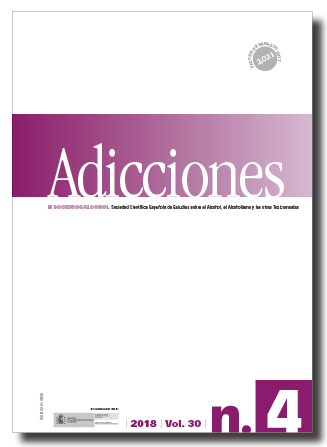Rol de la calidad de vida en el consumo de riesgo de alcohol: ¿debe ser una variable más relevante en cualquier investigación en este campo
DOI:
https://doi.org/10.20882/adicciones.1098Palabras clave:
Alcohol, Calidad de vida, AUDIT, EQ-5D-5LResumen
A partir de los datos basales del estudio EFAR-Spain para la validación de una intervención breve en línea en consumidores de riesgo de alcohol facilitado desde atención primaria nos hemos propuesto explorar la relación entre la calidad de vida (medida a través de la escala EQ-5D-5L ) y el patrón de consumo de alcohol (a partir del AUDIT). Utilizamos como variable principal dependiente la calidad de vida y las seis diferentes dimensiones de la misma (ansiedad/depresión, escala analógica-visual, dolor/incomodidad, movilidad, autocuidado, actividades diarias), y como variables independientes la puntuación en el AUDIT y los datos sociodemográficos. El análisis multivariante confirmó la asociación estadística de la calidad de vida (regresión linear B-0.25 IC95%-0.01 a -0.04), la subescala de depresión/ansiedad (regresión logística: OR 1.10 IC95% 1.08-1.22), y la subescala analógica-visual (regresión lineal B-0.27 IC95% -1.25 a -0.500) con puntuación total del AUDIT de forma independiente de los factores sociodemográficos. Teniendo en cuenta que en la asistencia del paciente con problemas de alcohol la reducción de consumo de alcohol puede ser un objetivo terapéutico alcanzable y respetuoso con la ética profesional en los casos leves y moderados y que la auto-evaluación del patrón de consumo de alcohol por parte del paciente no está exenta de minimizaciones en las cantidades y frecuencias, tal vez podría ser adecuado evaluar la evolución de nuestros pacientes en función de los cambios en la calidad de vida como respuesta al tratamiento. Abstract Using basal data from EFAR-Spain (A randomised controlled non-inferiority trial of primary care-based facilitated access to an alcohol reduction website) we explored the relationship between quality of life (QoL, as evaluated by EQ-5D-5L) and pattern of alcohol use (as evaluated by AUDIT) . Multivariate regression analyses were conducted using total QoL index and QoL six dimensions (anxiety/depression, Visual Analogue Scale (VAS), pain, mobility, self-care, daily activities) as dependent variables and AUDIT score and sociodemographic data as independent variables. Adjusting for sociodemographic data, AUDIT score was a statiscally significant predictor of overall QoL (lineal regression B-0.25 95% CI -0.04 to -0.01), anxiety/depression (logistic regression OR 1.10 95% CI 1.08-1.22) and health VAS (lineal regression B-0.27 95% CI -1.25 to -0.500). Since reducing alcohol intake can be a reasonable and ethically correct therapeutic objective in mild and moderate alcohol use disorders and since alcohol use pattern self-assessment has several limitations, perhaps assessing changes in QoL over time could be useful to monitor our patients recovery. Palabras clave: alcohol, calidad de vida, AUDIT, EQ-5D-5L Keywords: alcohol, quality of life, AUDIT, EQ-5D-5L.Citas
Badia, X., Schiaffino, A., Alonso, J. y Herdman, M. (1998). Using the EuroQoL 5-D in the Catalan general population: Feasability and construct validity. Quality of Life Research, 7, 311-322. doi:10.1023/A:1008894502042.
Barrio, P. y Gual, A. (2016). Patient-centered care interventions for the management of alcohol use disorders: A systematic review of randomized controlled trials. Patient Preference and Adherence, 10, 1823-1845. doi:10.2147/PPA.S109641.
Barrio, P., Miquel, L., Moreno-España, J., Martínez, A., Ortega, L., Teixidor, L., … Gual, A. (2016). Alcohol in Primary Care. Differential characteristics between alcohol-dependent patients who are receiving or not receiving treatment. Adicciones, 28, 116–122. doi:10.20882/adicciones.779.
Baumeister, S. E., Gelberg, L., Leake, B. D., Yacenda-Murphy, J., Vahidi, M. y Andersen, R. M. (2014). Effect of a primary care based brief intervention trial among risky drug users on health-related quality of life. Drug and Alcohol Dependence, 142, 254-261. doi:10.1016/j.drugalcdep.2014.06.034.
Bradley, K. A. y Kivlahan, D. R. (2014). Bringing patient-centered care to patients with alcohol use disorders. JAMA, 311, 1861-1862. doi:10.1001/jama.2014.3629.
Gual, A., Arbesú, J., Zarco, J., Balcells-Oliveró, M. M., López-Pelayo, H., Miquel, L. y Bobes, J. (2017). Risky drinkers underestimate their own alcohol consumption. Alcohol and Alcoholism, 52, 516-517. doi:10.1093/alcalc/agx029.
López-Pelayo, H., Wallace, P., Segura, L., Miquel, L., Díaz, E., Teixidó, L., ... Gual, A. (2014). A randomised controlled non-inferiority trial of primary care-based facilitated access to an alcohol reduction website (EFAR Spain): The study protocol. British Medical Journal Open, 4 (12). doi:10.1136/bmjopen-2014-007130.
Luquiens, A. y Aubin, H. J. (2014). Patient preferences and perspectives regarding reducing alcohol consumption: Role of nalmefene. Patient Preference and Adherence, 8, 1347–1352. doi:10.2147/PPA.S57358.
O’Donell, A., Anderson, P., Newbury-Birch, D., Schulte, B., Schmidt, C., Reimer, J. y Kaner, E. (2014). The impact of brief alcohol interventions in primary healthcare: A systematic review of reviews. Alcohol and Alcoholism, 49, 66-78. doi:10.1093/alcalc/agt170.
Saunders, J. B., Aasland, O. G., Babor, T. F., de la Fuente, J. R. y Grant, M. (1993). Development of the Alcohol Use Disorders Test (AUDIT): WHO Collaborative Project on Early Detection of Persons with Harmful Alcohol Consumption—II. Addiction, 88, 791-804.








